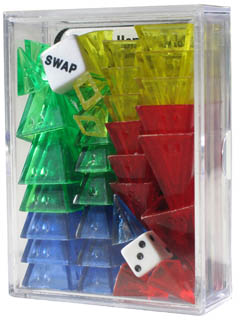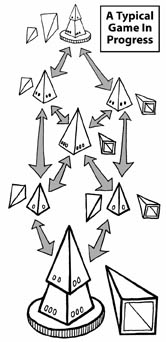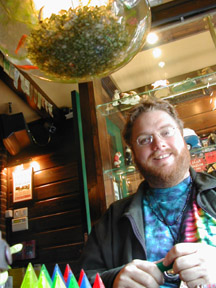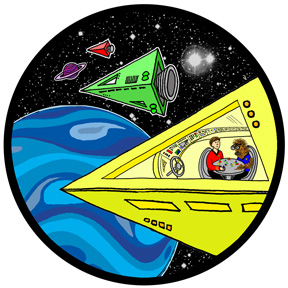 Andy's Page About Homeworlds
Andy's Page About Homeworlds
Contents:
- I Love Homeworlds!
- It's the True "Space Chess"
- Binary Homeworlds
- Adjusting the Stash
- My Binary Homeworlds Carrying Case
- 3HOUSE
- My Bank Board and my Starfield Playmat
- My Standard Opening Move
- Playing With Russell
- Tournament History
- Tournament Rules
- Using Xeno Colors
- The Official Rules
See Also:
I really like John Cooper's Icehouse game, Homeworlds. I think it's one of the very best Icehouse games we currently have. It's elegant and exciting, it looks great on the table, it's different every time, the theme rocks, and it makes excellent use of the pyramids. One of my criteria for a perfect Icehouse game is that it offer deep strategy while using little or no equipment other than the pyramids, especially including using the table itself as a featureless gameboard. Homeworlds is a perfect Icehouse game.
When I wrote the Author's Notes for The Empty City, I listed my 5 favorite Icehouse games as being Icehouse, IceTowers, RAMbots, Zarcana, and Volcano. I gave honorable mentions to Zendo and Homeworlds. But I've played a lot of games since I wrote that list, and these days, my very favorite Icehouse game is Binary Homeworlds. (I'm also pretty into Martian Hold'em.)
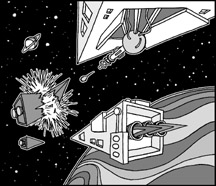
NOTE: This scene never actually happens in a game of Homeworlds. Attacking allows you to take control of enemy spaceships, rather than blasting them into pieces. (Ships in Homeworlds are only destoryed due to Catastrophes.) I originally drew this picture for the predecessor game IceTraders, in which such attacks are possible. |
Science Fiction shows have often attempted to depict the "Chess of the Future." Consider Mr. Spock's 3-D chess set, or the Next Generation's use of Terrace as a futuristic-looking chess-style game. Even that holographic battle-chess game seen in the first Star Wars movie (the game which C-3PO was advised to "let the Wookie win") was played with soldier-like pieces on a grid-style board. Meanwhile, in the world of real board games, the idea of a "space chess" set has previously been realized only by replacing the kings, queens, pawns, bishops, knights, and rooks on a traditional chessboard with spaceships of various kinds. Other space themed games I've played have relied on complex gameboards and even more complex sets of cards, tokens, and components. While some such games (most notably Cosmic Encounter) are wonderful and entertaining, they don't fill the niche of a true space chess game. Homeworlds does. Where Chess is an abstract pure strategy game representing medieval warfare between kings, Homeworlds is an abstract pure strategy game representing interstellar warfare between planets. In both games, complicated forces have been reduced to elegant icons, but where Chess is played on a restrictive, 64-square grid, Homeworlds creates a free-form, dynamic space-map out of any plain surface. Whereas Chess was a game played by Renaissance Kings, Homeworlds is a game for Starship Captains. |
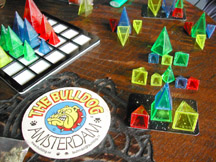 Homeworlds
with 2 players is a very different game from that with 3 or more.
The differences are significant enough that we've decided to
emphasize the distinction by referring to our modified
2 player version as Binary Homeworlds.
Homeworlds
with 2 players is a very different game from that with 3 or more.
The differences are significant enough that we've decided to
emphasize the distinction by referring to our modified
2 player version as Binary Homeworlds.
The designer considered the Good/Evil elements integral to the original game, and was originally worried that the 2 player version would be comparatively uninteresting, since those rules had no meaning in a 2 player game of Homeworlds.
However, after playing close to 100 games of Homeworlds during the course of the past year, mostly with just 2 players, I've come to conclude that John was backwards in his worries. To me, Binary Homeworlds is the superior game. The Good & Evil rules which allow 3 or more to play also add complexities that change the game from one of pure strategy to one of strategy + diplomacy + bluffing skill. And while those added elements are interesting, such games have not been anywhere near as compelling for me as the raw strategic challenge of Binary Homeworlds.
I now see Binary Homeworlds as the basic game, with the Good/Evil rules being optional add-ons. Much like Magic: The Gathering and Cosmic Coasters, extra rules have been devised to make the game playable by more than 2... but the pure head-to-head action of the basic game is what really rocks.
Ultimately, I find that Binary Homeworlds provides more replay value than regular Homeworlds because the results are always satisfying. In Binary Homeworlds, there's no luck factor to mess up your plans, no diplomatic failings to bring you down, and no hidden information you need to keep secret to succeed. Just as in the game which inspired the Good/Evil mechanism, you can lose regular Homeworlds for no reason other than being a bad liar... but in a Binary Homeworlds tournament, it's all about your skill as an imaginary admiral of the space fleet.
Aside from ignoring the Good/Evil rules, the only other difference between regular Homeworlds and Binary Homeworlds is in the number of Icehouse pieces used. Because controlling the limited economics of the game is what Homeworlds is really all about, we've found it better to limit the available number of pieces in the global stash to 3 of each size of each color. (I also recommended using 4 of each size & color when you have 3 players.)
My Binary Homeworlds Carrying Cases
I've been carrying an Icehouse set of one sort or another everywhere I go pretty much ever since we invented them. At first, it was a wood set in a drawstring bag. More recently, it's been a 5.3 stash set (5 colors plus 5 small blacks, for Volcano) in a hemp drawstring bag. Now what I usually carry around is an IceTowers boxed set loaded with extras (two more stashes (green & orange) plus PwP, a chessboard bandana, Homeworlds cards, extra catalogs, ICE-7s, and Marlene's Guide to Icehouse).
But I also have a very special Icehouse set which I keep in my bag whenever I think I might get to play Binary Homeworlds. It's a limited-sized Icehouse set intended only for that purpose, which I carry in a really-cool black plastic case I got with a Mag-Lite flashlight once.
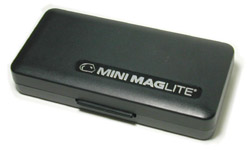
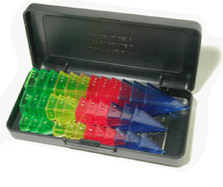
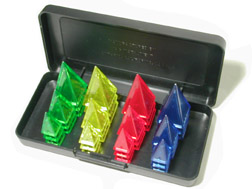
![]() See
how perfect it is? It's just the right size to hold the 36 piece
set, and you can use it to organize the global stash during a
game!
See
how perfect it is? It's just the right size to hold the 36 piece
set, and you can use it to organize the global stash during a
game!
There's also room inside for a set of Homeworlds cards, which are handy even when you're playing just with 2. That little swatch of space goes a long way towards reminding you of the game's theme (particularly if you're playing on a black table) and of course, they indicate which systems are the Homeworlds. I also keep a Homeworlds reference card (from ICE-7) on the table when we play... it's really nice when someone asks what you're playing to have a rules summary so concise to let them look at! We also use it to mark which player's turn it currently is.
|
My Travel-Sized Binary Homeworlds Carrying Case
|
We first published the rules for Homeworlds in Playing with Pyramids in 2002, immediately after John finished designing it. In 2007, we published the rules again in a booklet called 3HOUSE. I strongly recommend starting with the 3HOUSE version. It includes a lot more diagrams (like the one shown here), strategy info, nomenclature, tips, etc, which we've figured out in the last 5 years.  |
|
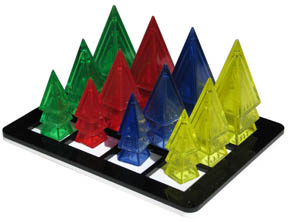 |
My Starfield Playmat Setting aside things like that light table at the Icehouse Lounge (in Vegas) or that black window ledge at the La Canna Coffeeshop (in Amsterdam), my favorite surface for a game of Homeworlds is this round starfield playmat which I created by cutting a 2' circle out of black felt and splattering it with drops of white paint. Making one of these playmats is a fun craft project and is the best way to get one since I doubt we'll ever follow through on the boxed set concept I described a few years ago (before the Treehouse Revolution). 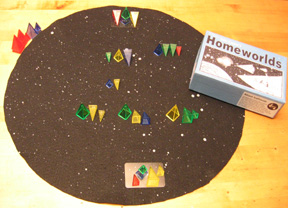 |
After trying out numerous different permutations, I now usually start with a Large Green ship and a Blue/Red star system. Here's why:
- I like having my initial Growth power in ship form so that I can sacrifice it later in the game.
- Yellow isn't needed until later and there's no particular benefit in having Yellow in your home star, so I never start with it.
- Red is very useful to have in the star system, since it provides what I call a Planetary Defense System.
- The best choice for size combo is what I call the Banker, which is Small/Medium. I actually think it's so much better that I recommend stronger players forgo that choice. My second choice is what I call Goldilocks, which is Small/Large. I use the Fortress, Medium/Large, only when I'm stuck with that choice.
- As for which color I choose for which piece in my star system,
I don't give it much thought unless I'm the second to build,
in which case I try to make sure my choices don't use up too
many of a particular size of color. I hate getting frozen out
of the red or blue economy because I unnecessarily used a vital
ship option as part of my star.
The first guy I've played a lot of Homeworlds with is my friend Russell. We play Homeworlds whenever we get together, which isn't as often as we'd like, since he lives a thousand miles away from me. But we've played everywhere from the Grassy Knoll to the Coffeeshops of Amsterdam (such as the Bluebird) and even the Icehouse Lounge in Las Vegas. I'm still eager to play again whenever we get together.
We've even played by email. Here's a detailed account of our first such game:
|
Andy vs. Russell, Play-By-Email Game #1 |
History of Binary Homeworlds Tournaments
During the first 4 Big Experiments, tournaments were held for either standard Homeworlds or its predecessor, IceTraders. I don't have any records on those games. I care only about Binary Homeworlds tournaments.
|
2011 Binary Homeworlds Champion: This year we had 4 players, but it quickly became two finalists, Andy and Joshua Kronengold. They fought an intense game which ended in a draw. Josh handily won the rematch. Winner: Joshua Kronengold |
 |
|
|
2010 Binary Homeworlds Champion: Only one challenger took on the 5 time champ, but he won! Andy cursed himself for saying "Sure, let's just make it one winner-take-all game" but that's what he said, and he lost! Winner: Tim Seiger |
 |
|
|
2009 Binary Homeworlds Champion: This tournament was run using chess clocks. Winner: Andrew Looney |
|
|
|
2008 Binary Homeworlds Champion: The 5th Binary Homeworlds tournament was held at Big Experiment #9 in 2008, again in the Floating Tournament format, but without a final game, the results being based simply on overall score. Winner: Andrew Looney |
|
|
|
2007 Binary Homeworlds Champion: The 4th Binary Homeworlds tournament was held at Big Experiment #8 in 2007, again in the Floating Tournament format. The finalsts were Dayle Hodge and Andrew Looney. Andy had lost to Dayle twice during their prelim games, but emerged victorious from the Finals. Winner: Andrew Looney |
 |
|
|
2006 Binary Homeworlds Champion: The 3nd Binary Homeworlds tournament was held at Big Experiment #7 in 2006 and while the participants were few, the competition was fierce. The finalsts were Jesse Welton and Andrew Looney, and after an epic 3+ hour game, Andy was the winner. Winner: Andrew Looney |
 |
|
|
2005 Binary Homeworlds Champion: The 2nd Binary Homeworlds tournament was held at Big Experiment #6 in 2005 and was far more successful due to the all-weekend-long floating tournament format devised by Liam (see below). We had 10 participants who played 17 games at random times throughout the weekend, and on Sunday afternoon the top two players had an exciting showdown. Those players were Jesse Welton, with a score of 6 (3 first-contact wins) and Andy Looney, also with a score of 6 (4 first-contact wins, 1 repeat win, and 3 losses). Winner: Andrew Looney |
 |
|
|
2004 Binary Homeworlds Champion: The 1st Binary Homeworlds tournament was held at Origins in 2004, and was run using a system of timer rules (see below) which I suggested we try and which didn't work out at all well. A three way tie resulted between myself, Russell, and Spanky Bob, and thus went into overtime. The final medallion wasn't awarded until months later, when the final tie-breaker game was played at Dragon*Con. Winner: Russell Grieshop |
||
You play whenever you can arrange a match against anyone you want to challenge. If you win, your score goes up by 1 point. If you lose, it goes down by 1 point. Also, an extra point is given to the victor if this is the first time these 2 have played together. When it's time for the finals, the two players with the highest overall scores play a final, winner-take-all battle for the championship.
|
Obsolete Timer rules: As noted above, I no longer advocate these rules. However, for history's sake, I'm not deleting them (But I am just making the text really tiny). They might still be useful for helping decide who is ahead when a game is unexpectedly stopped and not likely to be resumed.
|
The Rainbow Treehouse set provides the standard colors normally used for Homeworlds, however it can also be played with a 3HOUSE set made with Xeno colors. Here's the color translation we use:
- Cyan = Green
- Orange = Red
- Purple = Blue
- Clear = Yellow
In addition to appearing in 3HOUSE and Playing with Pyramids, the complete rules to Homeworlds can be found on John Cooper's website.
